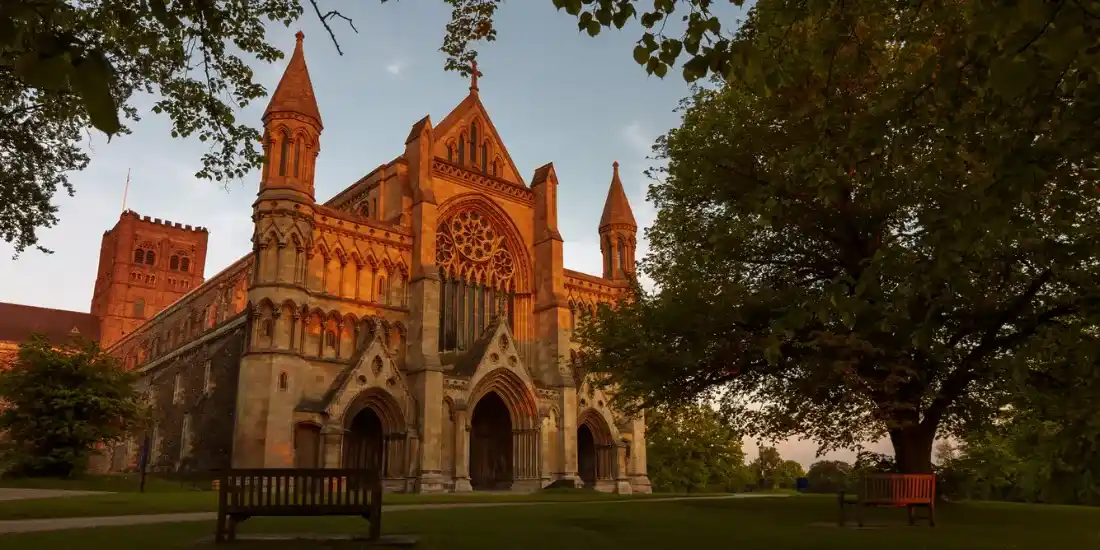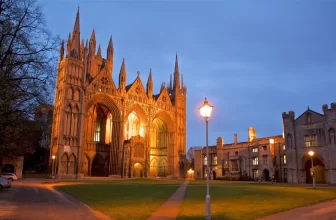
Welcome to St. Albans – The First Breath of Something New
The first thing that hits you when you step off the train at St. Albans City Station? The air. Yeah, really. It’s cleaner and crisper than what you’re probably used to-especially if you’re coming from a bigger city. There’s this soft earthy smell after it rains, a kind of mix between old stone and fresh-cut grass-you’ll notice it right away near Verulamium Park.
And then there’s the quiet. It’s eerie for the first five seconds, then deeply comforting. The streets have this mix of medieval charm and modern touch-black timber-framed pubs, indie coffee shops, and old Roman ruins that just casually exist right next to high street boutiques.
I remember my first morning walking past St. Albans Cathedral, jet-lagged and caffeinated, watching kids in uniforms swarming the local bakery and businesspeople heading to the station. It didn’t feel like a university town in the traditional sense-but that’s exactly the point. Studying in St. Albans isn’t about being in a flashy city. It’s about feeling safe, focused, and-best of all-part of a tight-knit community that genuinely gets it.
Trust me, if you’re someone who appreciates space, history, and a pace of life that lets you actually breathe while earning your degree, you’ll feel it from day one.
Why Study in St. Albans in 2026?
St. Albans probably wasn’t the first UK city on your study abroad radar. But you’d be wrong to overlook it in 2026.
For starters, it’s just 20 minutes away from Central London-so you can access everything the capital offers, minus the chaos and sky-high rent. You get the best of both worlds. And that’s not just a cliché-it’s genuinely how students survive studying here without burning out.
The UK government recently extended the Graduate Route Visa, giving you up to 2 years to stay and work after graduation (3 if you’re a PhD student). That’s huge. Tie that with St. Albans’ direct access to London tech, media, and finance sectors, and you’re looking at real post-study employment opportunities-without even needing to move.
Now, let’s talk numbers. The overall cost of living is about 15–20% lower than living in zones 1-2 in London. According to Numbeo, rent prices in St. Albans are around £1,200/month for a one-bedroom apartment, which sounds steep until you realize it’s £800–£1,000 less than renting the same in Central London-with better air and fewer tourists.
And culturally? This isn’t a one-note suburban town. It’s got Farmer’s Markets, indie cinemas, surprisingly buzzing food trucks, and yes-your local pub quiz Wednesdays are a thing here. In fact, I met most of my classmates over spilled pints and impossible trivia at The Six Bells.
So why 2026? Because competition is fair, jobs are stabilizing, hybrid degrees are growing (translation: you might not have to spend every day on campus), and UK institutions are leaning into personalized education models-which means smaller classes, stronger professor connections… and yes, better references when you graduate.
Why Is St. Albans Important for International Students?
So here’s the thing: St. Albans isn’t your classic university city, and that’s exactly where its charm lies.
It’s a hub that’s quietly been growing in student population-nearly 15% of students here are international, and that number is slowly ticking upward due to the overflow from London plus newer university programs expanding locally.
More importantly, you’re not thrown into the deep end. There’s actual support here-stuff that works. Dedicated international student advisors, free orientation weeks, and wellbeing hubs within every faculty. You feel seen here. Like, actually.
And here’s something most people don’t realize: St. Albans is strategically placed-close to Hatfield’s tech park, London’s media companies, and even Cambridge’s biotech hotspots. It’s part of the UK’s innovation triangle, and yes, real internships and part-time gigs are accessible-even without paying London rent.
Culturally? People are friendly. End of. It’s not forced either. Locals are used to students mixing in-whether it’s at Abbey Theatre on a discount student night or at the vintage record shop Empire Records, chatting music over espresso.
St. Albans might not be swarming with neon, but it’s a city that grows on you fast-because it actually works for students.
Top Universities and Colleges in St. Albans
Let’s break down your options. You’re probably weighing cost, vibe, ranking, and career support – so here’s an honest, non-brochure version of what’s actually available when you choose to study in St. Albans.
1. University of Hertfordshire (Hatfield Campus)
- Ranking: Top 50 in the UK, solid reputation for employability
- Known for: Engineering, Computer Science, Business, Health Sciences
- Tuition: £13,500–£16,500 per year for international students
- Vibe: Modern, diverse, industry-focused
- Campus energy: Everything’s on one big, well-connected campus. Students describe it as “city comfort with campus friendliness.”
Pro Tip: Great career-focused programs, especially if you’re eyeing a UK job post-study. Also very international-friendly with Global Buddies Scheme for new arrivals.
2. Oaklands College – St. Albans Campus
- Known for: Vocational courses, short-term certifications
- Tuition: Varies – most international programs start around £9,000/year
- Vibe: Very community-based, ideal for skill-focused students
- Campus feel: Quiet, green, but well-equipped with professional training centers
Useful for those looking at foundation years, HNDs, or one-year diplomas.
3. University College London (UCL) – Proximity Alert
Wait, what? Yep. Tons of St. Albans students commute to UCL, King’s, and SOAS. It’s daily doable, thanks to the fast trains into London (under 25 minutes).
If you’re accepted into a London uni but don’t want inner-city madness, St. Albans as a base is popular.
4. The University of Law – St. Albans
- Known for: LLB, LPC, and legal training
- Tuition: £14,000–£17,000 annually
- Vibe: Intense, professional, but incredible mentor support
- Proximity: Super central and well connected
If you’re into law or criminology, this is a hidden gem.
Top Student Accommodation Properties in St. Albans
Renting in St. Albans isn’t cheap-but it’s manageable if you know where to look.
1. Unite Students – Alban House
- Cost: £850–£950/month (all bills included)
- What You Get: Ensuite rooms, fast Wi-Fi, 24/7 security
- Pros: Walking distance to town center and bus stops to Hatfield
- Cons: Fills up quickly, limited rooms
2. Campus Living Villages (via Uni of Hertfordshire)
- Cost: £600–£800/month
- Proximity: On/near Hatfield campus but commonly used by St. Albans students
- Vibe: More studenty, with events, social boards, etc.
3. Private Rentals in Sopwell or Cottonmill
- Average Rent: £500–£700 (shared flat), bills extra
- Tip: Use SpareRoom or Rightmove. Look early-like, Feb-March early.
- Pros: More space
- Cons: You might end up further from public transport
4. Homestays
- Cost: £450–£600/month
- What it’s like: Staying with a local family. Great for adjusting if it’s your first international move.
Popular Student Areas in St. Albans
1. Fleetville
- Vibe: Chill, student-friendly, families and young professionals
- Rent: £550–£700 in shared flats
- Distance to Uni: 20 min bus to Hatfield, 10 min walk to St. Albans centre
- Food: Wings at Smokehouse Deli, affordable groceries at local Co-op
2. Sopwell
- Vibe: Diverse, quieter
- Rent: Slightly cheaper – £500–£650
- Transport: Well connected via St. Albans Abbey line
3. St. Peters Street
- Vibe: Lively, right in town
- Rent: Higher – £750+
- Pros: Access to literally everything-cafes, shops, pub quizzes
- Cons: Gets noisy during weekends
Pro tip: Always, always check bus/train access when moving into off-campus flats. The weather can 100% make or break your commute.
Cost of Living in St. Albans (2026 Breakdown)
Here’s what you really want to know: how much does it cost to study in St. Albans, and more importantly-how to not go broke halfway through your first semester.
Let me break it down for you.
| Expense Type | Low (£) | Medium (£) | High (£) |
| Accommodation (shared) | 500 | 700 | 900 |
| Food/Groceries | 120 | 180 | 250 |
| Transport (student pass) | 40 | 70 | 90 |
| Internet/Phone | 30 | 45 | 60 |
| Social/leisure activities | 50 | 100 | 200 |
| Academic Supplies | 30 | 50 | 80 |
| Misc/Health Insurance | 40 | 60 | 80 |
| Total per month | 810 | 1,205 | 1,660 |
Yes, things add up fast.
Money-Saving Hacks
- Student Railcard: Save 30% on travel-it pays for itself in literally two trips.
- Tesco Clubcard / Aldi hacks: Sounds basic, but meal planning will save you almost £60–£100/month.
- Get a UK SIM like Voxi or GiffGaff-don’t rely on roaming. It’s highway robbery.
- Cook in batches; eating out in St. Albans will sneak £12 out of your wallet way too often.
- Used textbooks or Open Library-don’t buy everything.
Where Students Overspend (and Regret It)
- Eating out (yes, that avocado toast and oat flat white lifestyle adds up)
- Late-night Ubers (trains get cheaper with planning, promise)
- Overpriced gym memberships-try uni fitness centers first
St. Albans isn’t cheap, but it becomes affordable when you’re budget-aware from the start.
Scholarships and Financial Aid in 2026
Here’s the deal: There are scholarships for international students to study in St. Albans (and surrounding unis), but they’re competitive and you need to start early-ideally 12 months before your intake.
Government and National Scholarships
- Chevening Scholarship (UK-wide)
- For Master’s students
- Covers tuition, travel, and living costs
- Deadline: November 2025
- NLP keyword alert: merit-based funding for postgraduate UK education
University-Specific Scholarships
- University of Hertfordshire International Merit Scholarships
- Up to £4,000 off tuition
- Based on academic performance
- Automatic consideration after application
- Law Bursary – University of Law, St. Albans
- £1,000–£3,000 financial support based on need
- Separate application required
External Funding Sources
- Commonwealth Scholarships
- British Council GREAT Scholarships
- Global Study Awards (British Council & ISIC)
Pro Tips for Applying:
- Highlight career goals and community impact in your essays.
- Apply early. Most deadlines are by Nov–Jan for the 2026 intake.
- Ask your undergrad professors for reference letters now-not two weeks before deadlines.
Also check platforms like ScholarshipPortal, study-UK.britishcouncil.org, or IEFA.org-they list funding for your discipline and passport.
How to Apply for 2026 – Step-by-Step
Let’s keep it simple.
Step 1: Shortlist Programs
- Start in October or November 2025
- Use platforms like UCAS, university websites, or Hotcourses Abroad
- Focus on course modules and career fit (not just rankings)
2: Prepare Documents
- Passport (valid through your course duration)
- Transcripts (translated and certified if needed)
- IELTS/TOEFL scores (Academic IELTS 6.0–6.5 is standard)
- Letter of Recommendation (2 minimum)
- CV or portfolio (if it’s a creative or business course)
3: Write SOP/Personal Statement
- Make it personal (why UK, why St. Albans, why this course)
- Be clear about long-term goals (post-study employment in the UK? Say it straight)
- Don’t fake it-admission officers can tell
4: Submit Applications
- Most UK unis use UCAS for undergrad (deadline Jan 2026)
- Master’s are direct applications (rolling basis, popular ones close by March 2026)
5: Wait, Interview, Offers
- Some courses (law, healthcare, business) might have virtual interviews
- Offers can range from early Jan to June 2026
6: Accept Offer + Pay Deposit
- Deposit: £1,000–£3,000 depending on school
- Accept before deadlines, usually within 2–4 weeks
7: Apply for UK Student Visa
- You’ll need a CAS (Confirmation of Acceptance for Studies) from your uni
- Apply no earlier than 6 months before course starts
- Visa success depends on showing funds + genuine study intent
Visa and Work Rules in 2026
Visas can feel scary. Deep breath-here’s everything you need to know.
UK Student Visa Requirements (2026)
- CAS letter from your university
- Proof of funds: approx. £1,334/month for 9 months = £12,006 in your account (can vary slightly by location)
- IELTS/English proof
- Immigration Health Surcharge: about £776/year
Work Rights During Study
- 20 hours/week during term
- Full-time during holidays
- Internship placements are typically allowed if they’re part of your course
Graduate Route (Post-Study Work)
- After doing your degree, you can stay 2 years (UG/PG) or 3 years (PhD)
- No job offer required before applying
- Doesn’t need sponsorship
Common Visa Rejections
- Not enough money in your account (needs to sit for at least 28 days!)
- Fake documents (don’t risk it)
- Weak personal statement or unclear career goals
Local Transport Facilities for Students
Getting around St. Albans is easy once you crack the basics. You won’t need a car-and probably shouldn’t even try.
Trains
- 20 minutes to London St. Pancras
- Trains every 10 minutes
- Student discount? 16–25 Railcard knocks off 1/3rd your travel costs
Buses
- Arriva buses connect you to Hatfield, Campus, and beyond
- Weekly or monthly passes: around £35–£50
- Most buses accept contactless or student cards
Cycling
- Bike lanes exist, but wear a helmet. Seriously.
- You can rent via HertsLynx or buy secondhand on Facebook Marketplace
Transport Tips
- Download Trainline for booking, Citymapper for routes
- Always check last train times-they’re not forgiving!
Student Life, Food, and Day-to-Day Vibes
Let’s be honest-your life won’t be all lectures and essays.
A typical week? Morning lectures, coffee runs at Nkora, evening library grinds (maybe), Friday pints, and weekend shopping at St. Albans Market or a cheeky trip into Camden.
Student Culture
- Loads of societies, especially at Hertfordshire’s main campus
- Pub quizzes, film clubs, international student mixers
- Not intense like London, but social energy is real
Food Culture
- Cheap Eats: Mezze House, The Waffle House (student fave), Fish and Chips across the cathedral
- International options? Try Tabure (Turkish), Taste of India, or Nando’s
- Supermarkets: Aldi, Tesco, M&S (treat yourself occasionally)
Mental Health & Wellbeing
- Uni offers free therapy, stress group sessions
- Honestly – most students don’t use it early enough. You should.
Weekends?
- Roast at a pub, walk the Roman Wall trail, train into London museums-for free!
Internship and Career Opportunities
You’ve probably heard the phrase “build your future” tossed around. Let’s get real about what that looks like here.
Key Industries Near St. Albans
- Tech (Hatfield, London)
- Business/Finance (City of London jobs via direct train)
- Law and Legal Services (University of Law network)
- Healthcare and Allied Health Programs
Paid vs Unpaid Internships
- You’ll find both. In 2026, more paid placements are available, especially through Tier 2 sponsorship companies
- Engineering/IT/Finance? Better chance of paid roles
How to Search
- Handshake, Prospects, and your uni’s job portal
- Career support is a thing here-use it!
- Network early-LinkedIn is surprisingly useful once in the UK
Application Timeline for 2026 (Month-By-Month)
| Month | What to Do |
| Oct–Dec 2025 | Research programs, shortlist unis |
| Jan 2026 | Finalize SOP, request references |
| Jan–March 2026 | Submit applications, apply for scholarships |
| March–June 2026 | Receive offers, send acceptance + deposit |
| June–July 2026 | Apply for visa + CAS form |
| August 2026 | Book flights, housing, pre-departure checklist |
| Sept 2026 | Fly in – Orientation week begins |
Public vs Private Universities in St. Albans
| Feature | Public University | Private University |
| Tuition Fees | £13,000–£16,500/year | £14,000–£18,000/year |
| Class Size | Larger | Smaller, more tailored |
| Prestige | Strong (e.g., Hertfordshire) | Niche-focused (e.g., Law) |
| Research Opportunities | Broader | Limited but specialized |
| Scholarships | More availability | Limited, but possible |
| Admission Requirements | More transparent | Case-by-case |
Final Thoughts – Why St. Albans Might Just Be Your City
Here’s what I’d tell my younger self before studying here: Don’t dismiss St. Albans just because it’s quieter than London.
It’s the kind of city that rewards you for looking closer. Less chaos, more space-mentally and physically. Real connections. Manageable cost. And-once you figure out the student rail pass situation-London is basically your playground.
If you’re serious about learning, want headspace, and crave proximity to careers without paying Zone 1 rent? This is it.
Top FAQs About Studying in St. Albans
Not as bad as you’d think. It’s around 15–20% cheaper than London, especially for rent and food.
Yes, 20 hours per week, full-time during holidays.
Nope. An IELTS 6.0–6.5 usually does it. Most programs support ESL students.
Very safe. Quiet, family-oriented, and rarely any late-night trouble.
Yes. Graduate Route Visa gives you 2–3 years to work without sponsorship.
Yes-especially merit-based ones for international students. Apply early (Oct–Nov).
Start now-research by Oct 2025, apply by Jan–March 2026 for best options.
Ready to make your move? You’ve got this.
And hey-don’t just aim for “studying abroad.” Aim to live abroad well. If St. Albans sounds like your pace, location, and kind of community-trust your gut.






